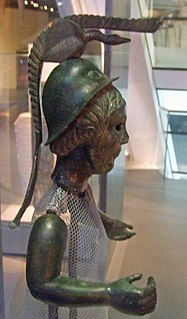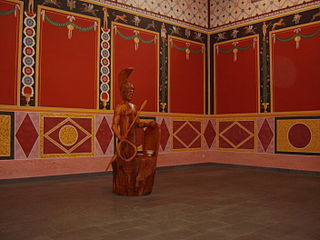Related Research Articles

Erecura or Aerecura was a goddess worshipped in ancient times, often thought to be Celtic in origin, mostly represented with the attributes of Proserpina and associated with the Roman underworld god Dis Pater, as on an altar from Sulzbach. She appears with Dis Pater in a statue found at Oberseebach, Switzerland, and in several magical texts from Austria, once in the company of Cerberus and once probably with Ogmios. A further inscription to her has been found near Stuttgart, Germany. Besides her chthonic symbols, she is often depicted with such attributes of fertility as the cornucopia and apple baskets. She is believed to be similar to Greek Hecate, while the two goddesses share similar names. She is depicted in a seated posture, wearing a full robe and bearing trays or baskets of fruit, in depictions from Cannstatt and Sulzbach. Miranda Green calls Aericura a "Gaulish Hecuba", while Noémie Beck characterizes her as a "land-goddess" sharing both underworld and fertility aspects with Dis Pater.

Coventina was a Romano-British goddess of wells and springs. She is known from multiple inscriptions at one site in Northumberland county of England, an area surrounding a wellspring near Carrawburgh on Hadrian's Wall. It is possible that other inscriptions, two from Hispania and one from Narbonensis, refer to Coventina, but this is disputed.

In ancient Celtic religion, Maponos or Maponus is a god of youth known mainly in northern Britain but also in Gaul. In Roman Britain, he was equated with Apollo.
In ancient Celtic polytheism, Verbeia was a goddess worshipped in Roman Britain. She is known from a single altar-stone dedicated to her at Ilkley. She is considered to have been a deification of the River Wharfe.
In Romano-British culture and Germanic polytheism, the Alaisiagae were a pair of Celtic and Germanic goddesses deifying victory.
Veteris was a Celtic god attested from many inscriptions in Roman Britain. The dedicants were usually private individuals and were exclusively male. During the 3rd Century AD the cult was particularly popular among the ranks of the Roman army.
Verostonos was a god in ancient Celtic polytheism, worshipped in Roman Britain. His name links him to alder-trees. Altar-stones raised to him have been recovered in the United Kingdom, such as that at Ebchester in County Durham . His association with Cocidius in that inscription suggests that he may have been linked with, or an epithet of, that more widely attested war god.
Mogons or Moguns was a Celtic god worshiped in Roman Britain and Gaul. The main evidence is from altars dedicated to the god by Roman soldiers.
Iouga is a suggested reconstruction of the name of a Romano-British goddess known from a single fragmentary inscription on an altar-stone at York. The name appears as Ioug[...] or Iou[...] on the damaged stone, which reads:
Satiada was a Celtic goddess worshipped in Roman Britain. She is known from a single, unadorned altar-stone dedicated to her at Chesterholm (Vindolanda). The inscription reads:
Senuna was a Celtic goddess worshipped in Roman Britain. She was unknown until a cache of 26 votive offerings to her were discovered in 2002 in an undisclosed field at Ashwell End in Hertfordshire by metal detectorist Alan Meek. Her imagery shows evidence of syncretism between a pre-Roman goddess with the Roman Minerva.

Brigantia was a goddess in Celtic religion of Late Antiquity.
Si deus si dea is an Archaic Latin phrase meaning "whether god or goddess". It was used to address a deity of unknown gender. It was also written sive deus sive dea, sei deus sei dea, or sive mas sive femina.

Lenus was a Celtic healing god worshipped mainly in eastern Gaul, where he was almost always identified with the Roman god Mars. He was an important god of the Treveri tribe, who had large sanctuaries at medicinal springs at Trier and the Martberg by Pommern in what is now Germany. Two dedications to him are also known from southwestern Britain. Edith Wightman characterizes him as “one of the best examples of a Teutates, or god of the people, equated with Mars—protector of the tribe in battle, but also [...] bestower of health and general good fortune” (p. 211). His sanctuary ‘Am Irminenwingert’ at Trier had a large temple, baths, smaller shrines and a theatre; that on the Martberg also included a large variety of buildings, probably including rooms for health-seeking pilgrims to stay. Despite his associations with healing, Lenus Mars is depicted classically as a warrior with Corinthian helmet in a bronze statuette from the Martberg.

Carrawburgh is a settlement in Northumberland. In Roman times, it was the site of a 3½ acre auxiliary fort on Hadrian's Wall called Brocolitia, Procolita, or Brocolita. This name is probably based on the Celtic name for the place, and one possible translation put forward is 'badger holes'. The fort there was a mile or so west of the Wall's northernmost point at Limestone Corner, and just over a mile west of the nearest milecastle, Milecastle 30. The fort either used the Wall itself as its northern rampart, or was built parallel to it but detached. It certainly postdates both the Wall and the vallum.

Uxelodunum was a Roman fort. It was the largest fort on Hadrian's Wall, and is now buried beneath the suburb of Stanwix, in Carlisle, Cumbria, England.
The Rudge Cup is a small enamelled bronze cup found in 1725 at Rudge, near Froxfield, in Wiltshire, England. The cup was found down a well on the site of a Roman villa. It is important in that it lists five of the forts on the western section of Hadrian's Wall, thus aiding scholars in identifying the forts correctly. The information on the cup has been compared with the two major sources of information regarding forts on the Wall, the Notitia Dignitatum and the Ravenna Cosmography.

Aballava or Aballaba was a Roman fort on Hadrian's Wall, between Petriana (Stanwix) to the east and Coggabata (Drumburgh) to the west. It is about one and a half miles south of the Solway Firth, and its purpose was to guard the south end of two important Solway fords, the Peat Wath and the Sandwath, which were also to become favourite routes for medieval border raiders.

Coggabata, or Congavata / Concavata, was a Roman fort on Hadrian's Wall, between Aballava to the east and Mais (Bowness-on-Solway) to the west. It was built on a hill commanding views over the flatter land to the east and west and to the shore of the Solway Firth to the north. Its purpose was to guard the southern end of two important Solway fords, the Stonewath and the Sandwath.

Toutatis or Teutates is a Celtic god who was worshipped in ancient Gaul and Britain. On the basis of his name's etymology, he has been widely interpreted to be a tribal protector.
References
- 1 2 Collingwood, R.G. and Wright, R.P. (1965) The Roman Inscriptions of Britain (RIB) Vol.I Inscriptions on Stone. Oxford. RIB 1897, online at www.roman-britain.org
- ↑ Dictionary of Celtic Myth and Legend, Miranda J. Green, Thames and Hudson Ltd, London, 1997
- ↑ Centre for Advanced Welsh and Celtic Studies, University of Wales. "Proto-Celtic—English lexicon." (See also this page for background and disclaimers.)

